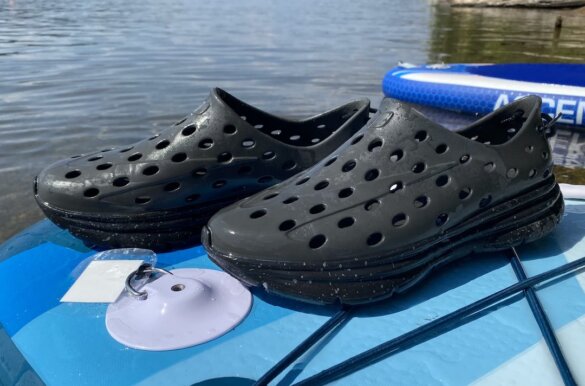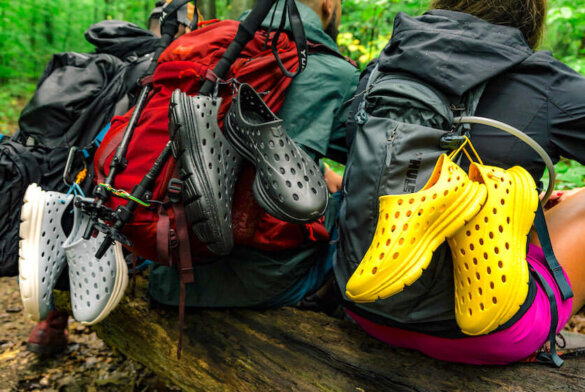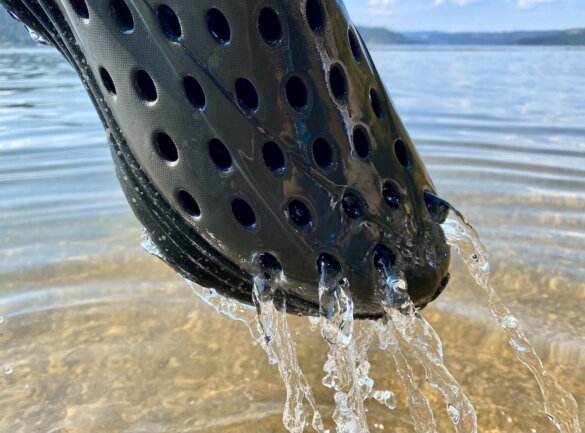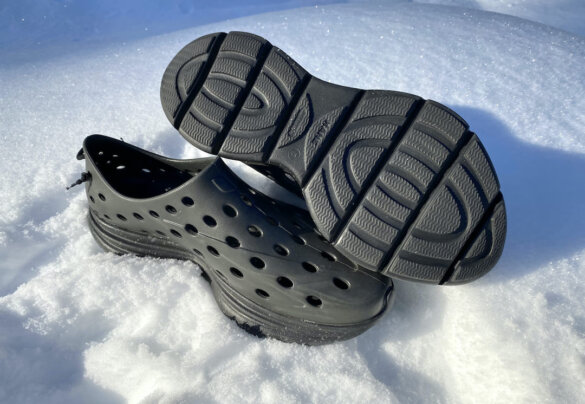The Kane Revive Active Recovery Shoe is essentially a modernized, stylish take on an EVA foam shoe. Kane markets it as a shoe you can wear after hard workouts to help you and your feet recover more quickly and comfortably — but we think the Revive is far more versatile than a typical recovery shoe.
To get us a closer look, Kane Footwear sent Man Makes Fire a review pair. After testing the Kane Revive shoes over several months during the review process, this what we learned:
Kane Revive Review

Kane makes its Revive shoes in Brazil from sugarcane-based EVA foam and ships them in the U.S. from Nashville, Tennessee. Kane is a certified B Corporation, which basically means the company is very transparent about its entire social and environmental impacts. Kane also says that 1% of its gross sales are committed directly to environmental non-profits through 1% for the Planet.
Even though Kane is a relatively new and small footwear company, the Kane Revive is a high-quality, well-built EVA foam shoe. Unlike popular clog-style foam shoes, the Kane Revive has a modern, sporty profile. It has a thick, stable sole yet manages to look sleek compared to clogs. Overall, the Revive is lightweight, moderately cushioned, and holds to your foot well.
My Experience with the Kane Revive Shoes
When I first tried the Kane Revive Active Recovery Shoes, I was curious if they would help my feet feel better after hard basketball workouts, long hikes, and longs days of skiing.
My answer is a guarded yes. The exterior holes let air flow around your feet and therefore let your feet breathe. The toebox is generous, which lets you feet spread out and relax — which is important if you had your dogs in tight shoes or boots before wearing the Revives.
Kane builds in a 10mm heel-to-toe drop, which makes the Kane feel more like regular shoe than a flatter slipper, flip-flop, or clog. Kane says this helps with blood flow and recovery.

Kane also touts little raised nodes on the footbed, which are supposed to stimulate and activate blood flow in key pressure points in your foot. I can feel them when I first put on the Revives — then they fade from my attention. I’m not sure if there’s a measurable increase in blood flow to my foot or not — and Kane doesn’t seem to publish any scientific studies to prove it.
If you need to air out your feet in a lightweight shoe for recovery after working out, the Kane Revive will likely be handy to have around. But I can’t say that it’s remarkably better than competitive foam shoes for this purpose.
Either way, I don’t think ‘Active Recovery’ is what makes the Kane Revive a great shoe. The Kane Revive is a great shoe because it’s lightweight, stable, durable, and versatile. Better yet, it looks like it’s designed for activity rather than shuffling around the kitchen on the way to the couch.
Shop the Revive at Kane for all the latest colors for both men and women!
Awesome Outdoor Shoe

The Kane Revive is an awesome outdoor shoe. While I haven’t yet worn the Kane Revive to the beach or river, I did wear them during a day at an indoor waterpark this winter. The Kane Revives gave me good traction on slick concrete and they stayed on my feet in and out of the water.
As a water shoe, they’ll protect your toes from rocks and drain water fast. One drawback as a water shoe is that the interior is a bit slick when wet. This means your foot isn’t locked down on the footbed, so you’ll want to keep that in mind if you’re running around or changing direction quickly. However, this is a common trait of foam-based shoes, so it’s not a drawback, just a characteristic to be aware of.
We think the Kane Revive is far more versatile than a typical recovery shoe.
While they’re not what I’d call a hiking shoe, you’ll likely be able to wear them to the beach and trek to your spot. Similarly, I can see taking them kayaking or standup paddleboarding. Remember they offer full-coverage protection to your toes, will protect the bottoms of your feet on rocks, and drain fast.
For camping this summer, I’ll definitely toss them in the back of the truck. While they’re not as easy to slip on as clogs in the dark for middle-of-the-night bathroom breaks, I’d much rather navigate uneven terrain with the Kane Revives than most other slip-on foam shoes.

Similarly, I can see taking the Kane Revives hiking or backpacking. They’re light enough to attach to the outside of your pack. I don’t know about you, but after hiking a dozen miles into a backcountry lake on a hot August day, I’m usually ready to jump in the lake. The Revives can protect your feet, let you wade around, and hike back to base camp.
The Fit

The Kane Revive fit is spot on to your usual running shoe size. The width seems average, but the toe box is roomy — as you would expect from a recovery shoe. The heel cup does a good job of securing my heel. I can wear the Revives for hours without socks without issues. The mid and forefoot is shaped to hold your foot without binding or pressure.
In fact, for me, the fit is surprisingly great. The Kane Revive moves with my foot without slop yet never feels tight.
The opening around your foot breaks in and gets a bit softer over time, but the footbed and flex feels the same as it did when I first put them on.
One drawback in ordering the Kane Revive is the return policy — there is a $10 handling/restocking fee for returns for a refund, but you can avoid the fee if you return the shoes for a gift card to use to buy another size or color. I think your risk of a size issue is small unless you have a challenging foot to fit — but the policy is something to be aware of.
Shop the Revive at Kane for all the latest colors for both men and women!
Take Them Everywhere
After several months of wearing the Kane Revives, I find myself choosing them on purpose for wearing around the house. Better yet, I almost always grab them to take on weekend trips. They’re so light and handy, I pack them all the time. I use them often as a house shoe, especially in the winter when I’m wearing boots outside.
In fact, I also wore them on a trip to the hospital for a same-day surgery. I wanted something lightweight, stable and easy to get on. The Kane Revives got the nod.
My testing period so far has been during cold winter months, so I tend to wear them like slippers with socks. The socks provide a bit of warmth and comfort, but they still breathe due to the holes.
I appreciate the Kane Revive shoes so much I added them to our Best Outdoor Gifts for Men gift guide.
Any Drawbacks?

The Kane Revives shoes are comfortable, stable and seemingly indestructible. Are there any drawbacks?
Sort of.
The first drawback is that in warm situations, your feet could sweat enough to make the interior wet. This can produce some squeaks with some people’s feet in some situations and/or reduce the stability of your foot on the footbed. This is a drawback common with every other foam shoe I’ve worn, so don’t hold it against Kane. Just be aware of it in case it matters to you.
Meanwhile the second drawback is more of personal style quirk. To me, I think the width of the sole under the forefoot is a half-inch unnecessarily wide. On my size 14 Revives, you could easily trim a 1/4″ on each side and still have plenty of sole for stability. Even though the Revive sole seems wider than necessary, the Revive moves with my foot and I’ve never stumbled or caught the sole on anything. So the preference here is more stylistic than functional . . . but I also can’t help but wonder if the sole will catch on rocks on rugged river and creek terrain.
What’s my point? The overall look the of Kane Revive is sleek and sporty . . . and yet also surprisingly wide. No one seems to notice, but when you get the Kane Revives in hand, be ready for a double-take on the width.
If Kane adds to its lineup with new models, I’d jump all over a slimmer, trimmer version — especially if Kane trimmed a bit of recovery footbed support in favor of extra-plush cushioning.
Competitive Alternatives & Options
There are lots of competitive foam shoes these days, likely due to the success of the popular Crocs clogs. In fact, if you’re looking for an alternative to Crocs that don’t look like a clog, the Kane Revive might be your best Croc alternative. As for ‘recovery shoes,’ most of the recovery shoe competition tends to be sandals or slides. Still, if you’re considering the full-coverage Kane Revive Active Recovery Shoes, you might be interested in these competitive options:
OOFOS OOcandoo Sandals — If you dig the look, the OOFOS OOcandoo Sandals have a patented footbed that absorbs 37% more impact than traditional foam footwear materials. For more versatile wear, the OOcandoo Sandals have full-foot coverage like the Kane Revive, as well as a Velcro strap for a tighter fit during activity or playing at the beach.
Sperry Water Strider — The Sperry Water Strider has a similar EVA-foam construction as the Kane Revive, but the Water Strider is better for use as a dedicated water shoe. One key difference in the sole is the use of siped rubber, which gives the Water Strider an edge when it comes to slick-surface traction. Read our full Sperry Water Strider review for more detail!
Vans Trek Slip-On — If you’re a fan of Vans, the simple one-piece design of the Vans Trek Slip-On is for you. One benefit is the smaller, trimmer, collapsible design. One drawback is the lack of support compared to the Kane Revive.
Merrell Hydro Hoc — The Merrell Hydro Hoc is a water shoe with a modern hybrid-clog design. The Hydro Moc features a heel strap you can flip forward for easy rear-entry. Or you can leave it back for more of a lockdown fit. The Hydro Moc will be best for lots of water use while the Kane Revive will be better for more everyday wear.
The Bottom Line: Kane Revive Shoes
All-in-all, the Kane Revive active recovery shoe is a surprisingly versatile, lightweight and rugged shoe. It’s stable, comfortable and you can wear the Revive with or without socks. The roomy toe box and airy upper lets your feet breathe and relax after a hard workout — but we appreciate the Kane Revive most for its go-anywhere, do-anything simplicity. You can wear the Revive at home, around town, or better yet, outdoors as a water or camp shoe. Very highly recommended.
Get the Gear:


